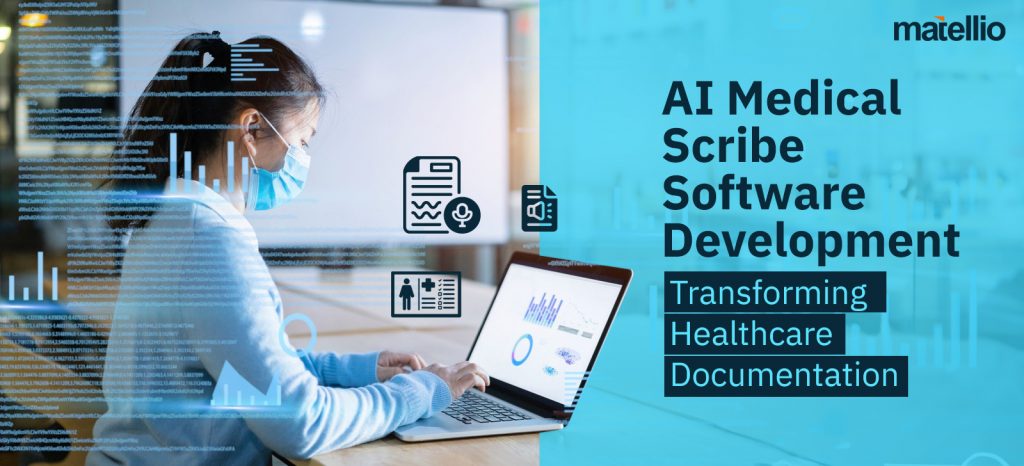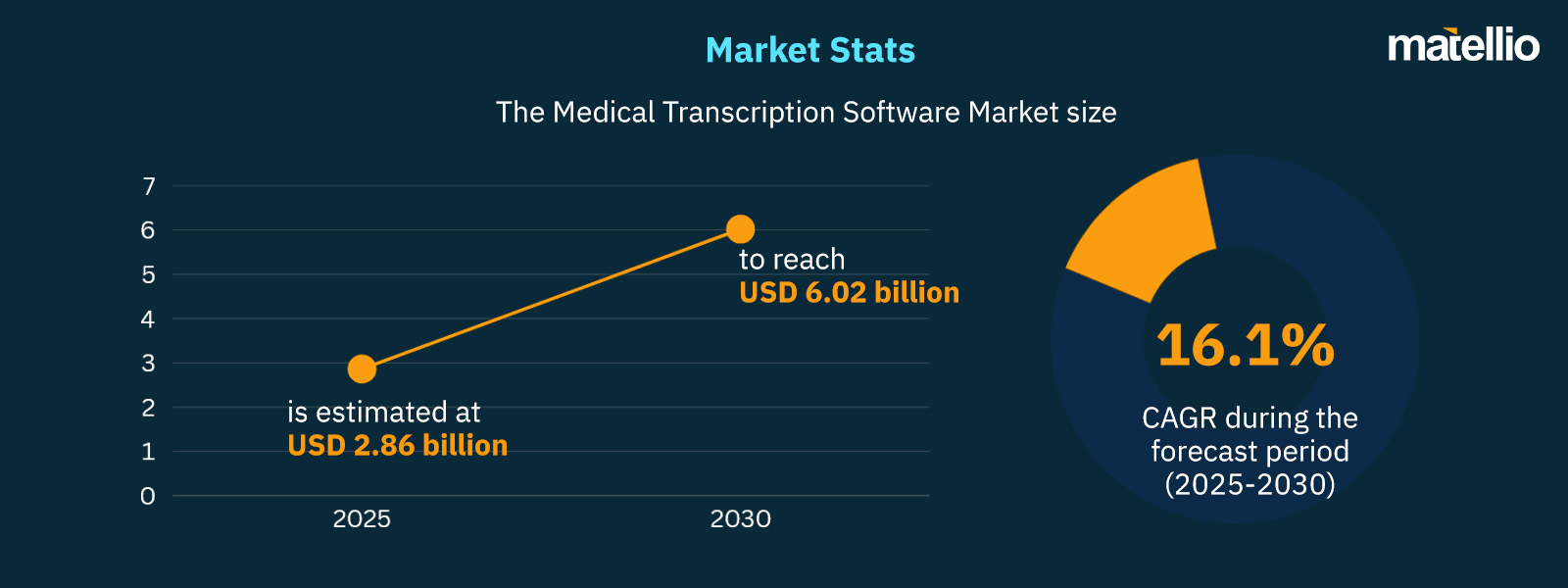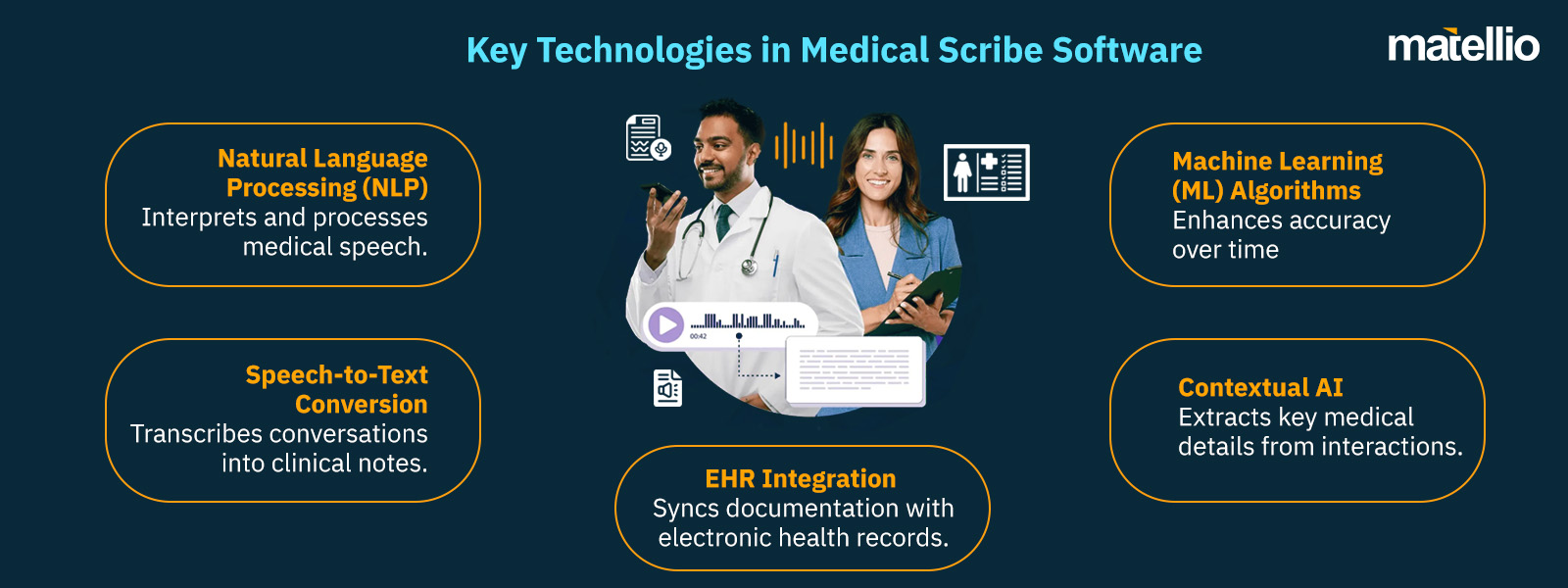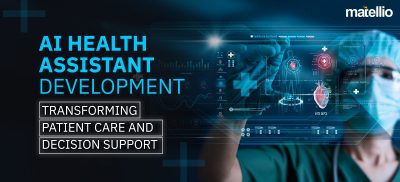
The healthcare industry is embracing automation to streamline workflows, improve patient care, and reduce administrative burdens. One of the most significant advancements in this space is AI medical scribe software, a technology designed to enhance clinical documentation by automating the process of recording and organizing patient data.
Medical professionals often spend valuable time transcribing notes, entering data into electronic health records (EHRs), and ensuring compliance with documentation standards. This manual approach can lead to inefficiencies, physician burnout, and errors in patient records.
With the increasing demand for accuracy and efficiency in healthcare documentation, investing in AI medical scribes development is becoming an essential tool for hospitals, clinics, and telemedicine providers. These solutions help physicians focus more on patient care while ensuring that clinical documentation remains precise, compliant, and up to date.
What is AI Medical Scribe Software?
AI medical scribe software is an intelligent digital assistant that listens to physician-patient interactions, extracts key medical information, and automatically generates structured clinical notes. It eliminates the need for manual documentation, allowing healthcare providers to enhance productivity while maintaining accuracy in patient records. By leveraging AI in healthcare, medical scribe software ensures real-time transcription and seamless EHR integration, optimizing workflow efficiency.
Source: Mordor Intelligence
How It Differs from Traditional Medical Scribing?
Traditional medical scribes are either in-person assistants or remote professionals who manually transcribe and enter medical data into EHRs. While effective, this method requires additional staffing and can be prone to human errors or inefficiencies.
In contrast, AI medical scribes use NLP and speech recognition to automate this process in real time. These solutions can analyze voice commands, extract relevant medical information, and integrate it seamlessly into EHR systems without human intervention. The result is faster, more reliable, and more cost-effective medical documentation.
Key Benefits of AI Medical Scribe Software
Healthcare providers are increasingly turning to AI medical scribe software development to streamline clinical documentation, reduce administrative burdens, and improve patient care. AI-powered medical scribes are transforming how physicians manage patient records. These solutions not only enhance accuracy but also ensure compliance with healthcare regulations while improving overall efficiency in clinical settings.
Enhancing Documentation Accuracy and Compliance
- Accurate and structured documentation is essential for ensuring quality patient care and meeting healthcare regulatory standards. Traditional manual notetaking is prone to human errors, omissions, and inconsistencies, which can lead to inaccurate medical records and potential compliance issues.
- Artificial intelligence medical scribe solutions eliminate these risks by capturing and structuring medical notes in real-time. These solutions automatically format documentation according to industry guidelines.
- It ensures that patient records are complete, up-to-date, and compliant with standards such as HIPAA and ICD coding. The software also minimizes transcription errors, reducing the likelihood of misdiagnoses and improving clinical decision-making.
Reducing Physician Burnout
- Physician burnout is a growing concern in the healthcare industry, with excessive administrative tasks being one of the primary contributors. Doctors often spend significant portions of their day manually documenting patient encounters, updating EHRs, and ensuring compliance, which detracts from their ability to focus on patient care.
- Leading AI medical scribe companies have developed solutions that automate documentation, significantly reducing the time physicians spend on administrative tasks.
- By handling transcription and structuring patient records in real-time, these solutions free up healthcare professionals to dedicate more time to direct patient interactions, leading to improved job satisfaction and reduced stress levels.
Improving Workflow Efficiency
- Efficiency in healthcare operations is critical to maintaining high-quality patient care and ensuring smooth clinical workflows. Manual transcription and documentation processes can slow down workflows, cause delays in updating medical records, and reduce overall productivity.
- With advancements in AI medical scribe technology, documentation is captured in real-time, enabling healthcare providers to streamline their workflows.
- AI-driven solutions integrate into existing healthcare systems, reducing the time spent on manual data entry while improving the speed and accuracy of documentation.
Seamless EHR Integration
- Electronic health records (EHRs) are the backbone of modern healthcare, providing a centralized repository for patient information. However, manually updating EHRs can be time-consuming and inefficient.
- The AI medical scribe cost is often outweighed by the efficiency gained through seamless integration with EHR systems.
- AI-powered scribes automatically update patient records, ensuring physicians always have access to the latest data without additional administrative work. This improves workflow efficiency and allows for better coordination of care.
Real-Time Transcription and Insights
- Unlike traditional dictation tools that require manual transcription and formatting, medical scribing solutions operate in real-time, capturing and processing conversations between doctors and patients instantly.
- These advanced solutions use NLP and AI-driven analytics to extract key medical information, organize it into structured formats, and provide actionable insights.
- Physicians can receive real-time recommendations based on past patient interactions, lab results, and diagnostic trends, enabling more precise and informed clinical decision-making. This capability enhances the overall quality of patient care by ensuring that no critical information is overlooked.
Enhanced Patient Interaction
- One of the challenges of manual documentation is that it often diverts a physician’s attention away from the patient. Doctors are frequently required to take notes, type into EHRs, or dictate observations while consulting with patients, which can create a less engaging and impersonal experience.
- With medical scribe AI software, documentation is automated, allowing physicians to maintain eye contact, actively listen, and engage more deeply with their patients. This improved interaction fosters better communication, strengthens doctor-patient relationships, and enhances overall patient satisfaction.
- With less time spent on administrative tasks, healthcare professionals can deliver more personalized and attentive care.
Cost Savings and Scalability
- Hiring human scribes or relying on traditional transcription services can be costly for healthcare organizations, especially when scaling operations. The cost of manual documentation services increases as facilities expand, requiring additional staffing and administrative resources.
- The integration of AI medical scribe automation significantly reduces these costs by providing an efficient, scalable solution that automates documentation with minimal human intervention.
- Once implemented, AI-powered scribe systems can support multiple physicians and departments, enabling healthcare providers to scale their operations efficiently without increasing labor costs.
Overcoming AI Medical Scribe Challenges
- While AI medical scribes offer numerous benefits, they also present challenges, such as accuracy in understanding medical jargon, adapting to different accents, and ensuring seamless integration with diverse EHR systems.
- To address these AI medical scribe challenges, modern solutions leverage continuous machine learning improvements, customizable AI models, and physician feedback to refine transcription accuracy and adaptability. These advancements ensure that AI scribes meet the specific needs of various healthcare settings.
Advancements Shaping AI Medical Scribe Software
- The continuous evolution of AI, voice recognition, and healthcare automation is driving significant improvements in AI medical scribes. As these technologies advance, AI-powered scribes are becoming more precise, seamlessly integrating with healthcare systems, and supporting multiple languages for broader accessibility.
- Key innovations include predictive AI for treatment recommendations, deeper telemedicine integration, and enhanced data analysis for better patient insights.
- With digital transformation services, AI-driven medical scribes are set to redefine healthcare documentation, streamlining workflows, reducing administrative burdens, and improving overall patient care.
Must-Have Features in AI Medical Scribe Software
To maximize efficiency and accuracy, custom AI medical scribe software should include both core and advanced features.
| Core Features | Next-Gen Features |
| Real-time speech recognition | AI-powered clinical decision support |
| Secure EHR integration | Predictive analytics for treatment recommendations |
| Medical terminology recognition | Multi-language and dialect support |
| Automated compliance tracking | Adaptive learning for personalized documentation |
| Customizable note templates | Voice biometrics for authentication |
| HIPAA-compliant data security | AI-driven coding and billing automation |
Revolutionize Clinical Documentation with Next-Gen AI-Powered Medical Scribe Solutions!
Challenges Solved Using Custom AI Medical Scribe Software
Healthcare providers face numerous challenges in clinical documentation, from accuracy issues to administrative burdens. Traditional methods of medical scribing rely on manual data entry, which not only increases the risk of errors but also consumes valuable time that could be spent on patient care. AI medical scribe software development offers a transformative solution, automating documentation processes, improving compliance, and streamlining clinical workflows. Below are the key challenges healthcare professionals encounter and how custom AI-powered solutions effectively address them.
Data Entry Errors
Challenge:
Manual documentation is prone to human errors, including typos, misinterpretations, and incomplete records. These inaccuracies can compromise patient safety, lead to misdiagnoses, and cause billing discrepancies.
Solution:
Artificial intelligence medical scribe solutions use natural language processing (NLP) and machine learning algorithms to capture physician-patient interactions accurately in real-time. Automated transcription ensures structured, error-free documentation while continuously improving accuracy based on usage patterns. This minimizes the risk of miscommunication and enhances the overall reliability of medical records.
Physician Workload
Challenge:
Excessive paperwork is a significant contributor to physician burnout. Doctors spend a substantial amount of time manually entering patient information, updating records, and ensuring compliance with regulatory requirements, limiting the time available for direct patient care.
Solution:
AI medical scribe companies offer automation-driven solutions that significantly reduce the time physicians spend on administrative tasks. By handling transcription and structuring patient records in real-time, these solutions free up healthcare professionals to dedicate more time to direct patient interactions, leading to improved job satisfaction and reduced stress levels.
Time-Consuming Documentation
Challenge:
Traditional scribing methods, whether manual notetaking or reliance on human scribes, slow down the documentation process. Delays in transcribing and updating records impact workflow efficiency and extend patient wait times.
Solution:
With medical scribing solutions, documentation is automated and streamlined. AI-based transcription captures and structures information during patient visits instantly, enabling faster patient turnaround times. This improves overall operational efficiency by reducing documentation delays and enhancing the speed at which physicians can attend to their next patient.
Integration with Healthcare Systems
Challenge:
Many healthcare providers struggle with interoperability issues when attempting to integrate documentation tools with existing EHR systems. Disconnected systems lead to workflow inefficiencies, requiring manual data transfers that increase administrative workloads.
Solution:
Medical scribe AI software integrates seamlessly with EHRs and other healthcare platforms through API connections, enabling automatic updates and smooth data exchange. This eliminates the need for manual data entry, ensures real-time synchronization across systems, and enhances the continuity of patient care.
Regulatory Compliance
Challenge:
Failure to comply with healthcare documentation standards, such as HIPAA and ICD guidelines, can result in legal complications, penalties, and compromised patient confidentiality. Manual documentation increases the risk of non-compliance due to human oversight.
Solution:
AI medical scribe automation solutions come with built-in compliance frameworks that automatically align with healthcare regulations. Features such as automated compliance tracking, encrypted data storage, and role-based access control ensure that medical records meet legal and security requirements. These features reduce the risk of non-compliance and safeguard sensitive patient information.
Limited Patient Interaction
Challenge:
Doctors often focus on taking notes and updating records during consultations, reducing meaningful engagement with patients. This lack of interaction can lead to lower patient satisfaction and missed opportunities for effective communication.
Solution:
With AI medical scribe solutions, documentation is handled in the background, allowing physicians to fully engage with their patients. By eliminating the need for manual notetaking, doctors can maintain eye contact, actively listen, and build stronger patient relationships. This enhances communication, improves patient trust, and leads to more personalized care experiences.
AI Medical Scribe Challenges and Adaptability
Challenge:
Adapting AI medical scribes to understand complex medical terminology, accents, and diverse patient cases can be challenging. Additionally, physicians may face initial resistance to adopting AI solutions due to concerns about accuracy and integration.
Solution:
Continuous machine learning improvements, customizable AI models, and user feedback help refine transcription accuracy and adaptability. AI scribes evolve to fit various healthcare environments, improving effectiveness over time. Additionally, healthcare providers implementing AI Based Chatbot Development Services alongside AI scribes can enhance patient engagement by automating responses to routine queries, allowing medical staff to focus on critical cases.
Read More: AI chatbots are transforming healthcare by enhancing patient engagement and automating administrative tasks. Discover how Medical AI Chatbot Development can improve efficiency and streamline operations.
Steps to Develop AI Medical Scribe Software
Developing AI medical scribe software development requires a structured approach to ensure it meets the needs of healthcare professionals while maintaining compliance, accuracy, and efficiency. From defining objectives to selecting the right technologies and ensuring seamless EHR integration, every step plays a crucial role in creating a powerful solution. Below is a detailed breakdown of the essential steps involved in AI medical scribe software development and how our experts can assist in each phase.
Identifying Business and Technical Requirements
- Understanding the specific challenges in healthcare documentation is the first step toward building a successful artificial intelligence medical scribe. Defining the software’s key objectives ensures that it aligns with clinical workflows, physician preferences, and industry compliance requirements.
- A clear roadmap allows for seamless integration with existing hospital and clinical systems while addressing documentation pain points.
- Our team collaborates closely with healthcare stakeholders, including physicians, IT teams, and compliance officers, to analyze workflow inefficiencies, identify must-have features, and outline technical specifications. We ensure that the final solution aligns with real-world clinical needs while enhancing efficiency and accuracy.
Choosing the Right AI and NLP Technologies
- AI medical scribe companies must incorporate powerful AI and natural language processing (NLP) technologies to accurately interpret medical terminology, recognize different accents, and structure documentation effectively.
- The choice of machine learning frameworks, speech recognition models, and contextual AI tools determines the software’s ability to capture, transcribe, and process patient-physician interactions in real-time.
- We integrate the latest AI and NLP models that enhance contextual understanding, ensuring precise and real-time medical transcription. Our solutions incorporate adaptive learning capabilities, enabling AI scribes to improve accuracy over time-based on physician feedback and evolving medical language trends.
Developing a Secure and Scalable Architecture
- AI medical scribe cost is influenced by the need for scalability, security, and regulatory compliance. The system must efficiently handle vast amounts of patient data while ensuring seamless expansion across multiple healthcare facilities.
- Scalability ensures that the software can accommodate increasing workloads, new medical specialties, and future advancements in AI-driven documentation. We develop a secure, scalable, and regulatory-compliant architecture designed to meet the highest standards of data protection and system performance.
- Our HIPAA-compliant solutions safeguard patient confidentiality, while cloud-based or on-premise deployment options provide flexibility based on an organization’s IT infrastructure.
- As a Healthcare Software Development Company, we ensure that our solutions are designed to integrate seamlessly with existing healthcare systems while remaining adaptable to evolving technological needs.
Building Custom Features and EHR Integration
- To maximize efficiency, medical scribing solutions must integrate seamlessly with Electronic Health Record (EHR) systems and offer custom features such as voice commands, automated transcription workflows, and real-time analytics.
- Smooth interoperability with healthcare management platforms enhances usability, reduces manual entry, and ensures that patient records are updated instantly.
- Our experts customize AI scribes with tailored workflows, voice recognition optimizations, and seamless EHR API integration to enable automated data synchronization.
- Whether it’s adapting templates for specialty-specific documentation or optimizing data exchange with existing hospital systems, we ensure that the solution enhances day-to-day clinical operations.
Testing and Deployment
- Thorough testing is crucial to ensure that medical scribe AI software operates efficiently, accurately, and securely before deployment. Functional, security, and performance testing help identify potential issues, while real-world testing in clinical settings ensures that the software meets physicians’ expectations.
- We conduct extensive testing across multiple healthcare environments, eliminating transcription errors, optimizing AI learning models, and ensuring a seamless user experience.
- Our deployment strategies prioritize smooth implementation with minimal disruptions, providing physicians with hands-on training and support.
Ongoing Support and Enhancements
- AI medical scribe challenges include evolving compliance requirements, changing medical terminologies, and the need for continuous AI learning to maintain accuracy. Ongoing support ensures that AI medical scribes remain efficient and up to date.
- We provide long-term support, performance monitoring, and regular updates to keep AI medical scribe software running at peak efficiency.
- Our team ensures that the software adapts to new medical terminologies, enhances accuracy through AI-driven refinements, and incorporates new compliance measures as needed.
Cost Factors to Consider Before Investing in AI Medical Scribe Software
Investing in AI medical scribe software development requires careful financial planning to ensure cost efficiency, seamless integration, and long-term value. Various factors influence the total investment, including technology selection, AI training, compliance requirements, and ongoing maintenance. Below, we explore the key cost factors that healthcare providers should evaluate before adopting an AI-driven medical scribe solution.
Customization Requirements
The level of customization required directly impacts the cost of medical scribing solutions. Healthcare providers often need tailored features such as real-time voice recognition, specialty-specific templates, and AI-powered transcription adjustments.
Customizing AI scribes to adapt to unique physician workflows, regulatory standards, and integration with existing hospital systems can significantly increase development expenses. However, this investment ensures higher accuracy, enhanced workflow efficiency, and an AI solution that aligns with specific healthcare needs, ultimately reducing administrative burdens and improving documentation quality.
AI Model Training and Accuracy Enhancement
Developing an artificial intelligence medical scribe requires extensive AI model training to recognize medical terminology, physician dictation patterns, and diverse accents. This involves large-scale data annotation, supervised learning, and continuous improvements to refine accuracy.
The cost of training AI increases with the complexity of medical transcription tasks. Advanced AI models require access to vast datasets, compliance with data privacy regulations, and ongoing machine learning refinements. Leveraging ML model development services can enhance AI scribes by continuously learning from real-world use cases, improving transcription accuracy and adaptability over time.
EHR and Healthcare System Integration
AI scribes must integrate seamlessly with AI medical scribe companies and existing Electronic Health Record (EHR) systems to ensure real-time data exchange and automated documentation updates.
Integration costs include API development, compatibility testing, and compliance with healthcare interoperability standards such as HL7 and FHIR. By ensuring seamless connectivity between AI scribes and hospital management systems, healthcare providers can streamline workflows, minimize manual data entry, and enhance patient care efficiency.
Technology Stack Selection
The choice of technologies used in AI medical scribe technology significantly affects cost, performance, and scalability. Below is a breakdown of the essential components in the tech stack for AI-driven medical scribe software:
| Functionality | Technology/Tools |
| Frontend Development | React, Angular, Vue.js |
| Backend Development | Node.js, Django, Flask, .NET Core |
| Speech Recognition | Google Speech-to-Text, IBM Watson Speech API, AWS Transcribe |
| Natural Language Processing | OpenAI GPT, BERT, SpaCy, NLTK, Hugging Face Transformers |
| AI & Machine Learning | TensorFlow, PyTorch, scikit-learn |
| Database Management | PostgreSQL, MySQL, MongoDB, Firebase |
| Cloud Services | AWS Lambda, Google Cloud AI, Microsoft Azure AI |
| Security & Compliance | HIPAA Compliance, OAuth 2.0, SSL/TLS, AES Encryption |
| EHR Integration | HL7, FHIR, SMART on FHIR APIs |
| Voice Processing & Dictation | Nuance Dragon Medical, Amazon Alexa SDK, Microsoft Speech SDK |
| Analytics & Reporting | Tableau, Power BI, Elasticsearch |
| DevOps & CI/CD | Docker, Kubernetes, Jenkins, GitLab CI/CD |
| Testing & QA | Selenium, Appium, Postman, JMeter |
Selecting an optimized technology stack ensures that medical scribe AI software meets industry standards while remaining cost-effective and scalable.
Scalability and Deployment Infrastructure
Hospitals and clinics require scalable AI scribe solutions to accommodate growing patient volumes, multiple locations, and evolving documentation requirements. Deploying AI medical scribe automation on a cloud-based infrastructure ensures flexibility, allowing organizations to scale as needed.
Cloud-based deployment models also reduce the need for expensive on-premise hardware, making AI scribes more cost-efficient in the long run. By implementing scalable AI models, healthcare facilities can future proof their documentation processes and ensure seamless integration with evolving medical technologies.
Compliance and Data Security Investments
Security and regulatory compliance are critical factors when investing in AI medical scribe cost solutions. Healthcare data is highly sensitive, requiring strict encryption, access control mechanisms, and regular security audits to ensure protection against cyber threats.
Compliance with regulations such as HIPAA, GDPR, and local healthcare laws adds to the overall cost, as it involves implementing secure authentication, role-based access control, and data retention policies. By prioritizing compliance, healthcare organizations can prevent legal risks, protect patient data, and ensure adherence to medical documentation standards.
Training and Continuous AI Model Improvement
AI scribes require continuous training to maintain high accuracy, adapt to evolving medical terminologies, and refine transcription capabilities based on real-time feedback. Ongoing costs include optimizing AI models, training healthcare professionals on AI medical scribe solutions, and integrating feedback loops to enhance system performance.
Ensuring that medical staff is comfortable using AI scribes is essential for maximizing productivity and minimizing manual corrections. Regular software updates and AI enhancements contribute to long-term cost savings by improving workflow efficiency and reducing reliance on human transcriptionists.
Support and Maintenance
Long-term success with AI scribes depends on proactive maintenance, software updates, and technical support. Regular updates help keep AI medical scribe future solutions cost-effective by preventing system failures and ensuring alignment with evolving medical practices.
Support services also cover bug fixes, user assistance, compliance adjustments, and AI model refinements to enhance overall performance. A well-supported AI scribe system guarantees seamless documentation, reduced physician workload, and improved healthcare efficiency.
Ready to Enhance Medical Documentation with a Custom AI Scribe?
Future of AI Medical Scribe Software
As artificial intelligence continues to advance, AI medical scribe software development is set to play an increasingly crucial role in healthcare. The need for more efficient documentation, reduced administrative burden, and improved patient outcomes is driving rapid innovation in this space. AI medical scribe software will evolve beyond just transcribing physician-patient interactions; it will become a powerful tool for clinical decision-making, workflow automation, and patient data management. Below are key trends shaping the future of AI medical scribe technology and how they will redefine healthcare documentation.
Increased Adoption of AI in Healthcare
AI-driven medical scribes are becoming a necessity for modern healthcare providers. Hospitals, clinics, and private practices are leveraging AI medical scribe solutions to enhance efficiency, improve documentation accuracy, and reduce physician burnout. With the growing demand for automation, AI integration services are playing a crucial role in ensuring seamless deployment and interoperability of AI scribes with existing healthcare systems. The integration of AI in medical scribing is expected to grow as more healthcare institutions recognize the benefits of automated documentation.
Enhanced Multilingual Capabilities
Future AI scribes will expand their linguistic capabilities, supporting multiple languages and dialects to cater to diverse patient populations. This advancement will allow AI medical scribe companies to develop solutions that enhance accessibility in multilingual healthcare environments, improving communication and documentation accuracy across global healthcare institutions.
AI-Powered Clinical Decision Support
Medical scribes will move beyond transcription to provide valuable insights for clinical decision-making. AI scribes will analyze real-time patient data, flag potential risks, and offer treatment recommendations based on historical records and clinical guidelines. This shift will make AI medical scribe cost a valuable investment, as the software will assist physicians in delivering more informed and timely patient care.
Improved Voice Recognition Accuracy
Speech recognition technology is continuously improving, enabling AI medical scribes to capture physician-patient interactions with higher precision. By leveraging medical scribing solutions, future AI scribes will recognize complex medical terminology, different accents, and contextual nuances, reducing transcription errors and improving overall documentation efficiency.
Integration with Wearable Technology
Wearable devices are becoming integral to healthcare, and AI scribes will seamlessly integrate with these technologies. By synchronizing with real-time health monitoring tools, medical scribe AI software will capture patient vitals and health trends, allowing physicians to make data-driven decisions without manual documentation. This integration will enhance proactive patient care and streamline medical workflows.
Voice-Activated Command Systems
Future AI medical scribes will function as hands-free assistants, allowing physicians to use voice commands for data retrieval, patient record updates, and appointment scheduling. The implementation of AI medical scribe challenges, such as physician adoption and workflow adaptation, will be addressed through intuitive voice-driven interfaces, making documentation more efficient and user-friendly.
More Personalized AI Training Models
Machine learning algorithms will continuously refine AI scribes to adapt to physician preferences and documentation styles. The ability to learn and customize workflows will ensure that AI medical scribe future solutions become more intuitive, aligning with specific clinical environments and reducing the need for manual adjustments. This personalization will significantly enhance physician satisfaction and efficiency.
Integration with Robotic Process Automation
As healthcare automation evolves, AI scribes will be integrated with RPA in healthcare, automating repetitive administrative tasks such as billing, claim processing, and scheduling. This collaboration between AI scribes and RPA will streamline back-office operations, allowing healthcare providers to focus on patient care while improving operational efficiency.
Scalability and Cloud-Based Deployments
The future of AI medical scribes will see increased adoption of cloud-based and scalable solutions. With the rise of AI medical scribe technology, healthcare providers will have the flexibility to deploy AI scribes across multiple facilities, ensuring seamless documentation and standardized workflows across an entire healthcare network.
Regulatory Compliance and Enhanced Security
Data privacy and compliance are top concerns in healthcare. AI scribes will incorporate advanced encryption, access control, and compliance tracking to align with industry standards. As AI medical scribe automation becomes more widespread, ensuring HIPAA, GDPR, and other regulatory adherence will be a priority for developers and healthcare institutions.
Need Expert Guidance for Developing Cutting-Edge AI Medical Scribe Software?
How Can Matellio Help with AI Medical Scribe Software Development?
Streamlining clinical documentation is essential for improving efficiency, reducing physician burnout, and ensuring compliance in modern healthcare. AI medical scribe software development enables real-time transcription, automated note generation, and seamless integration with EHR systems, allowing healthcare providers to focus on patient care instead of administrative tasks.
Why Choose Matellio?
- At Matellio, we specialize in developing AI medical scribe solutions that transform how healthcare professionals handle clinical documentation. Whether you need real-time voice transcription, NLP-powered medical note generation, or automated compliance tracking, our tailored solutions address your specific requirements.
- Our AI-driven medical scribe software leverages artificial intelligence medical scribe technology to recognize complex medical terminology, adapt to physician workflows, and enhance documentation accuracy. With advanced machine learning and speech recognition capabilities, our solutions help reduce errors and improve note-taking efficiency.
- Matellio ensures that your medical scribe AI software integrates seamlessly with your existing healthcare infrastructure, including EHR systems, hospital management platforms, and voice dictation tools. This ensures real-time data synchronization, reducing manual entry and improving workflow automation.
- With technology consulting services, we optimize your software by integrating predictive analytics and automation, enabling healthcare providers to gain real-time insights, streamline documentation workflows, and enhance physician efficiency. By automating administrative processes, we help reduce operational burdens and improve overall clinical productivity.
- From initial consultation and software design to deployment and ongoing support, Matellio provides end-to-end services to ensure your AI medical scribe automation solution operates flawlessly. We prioritize scalability, security, and future-proof development to meet the evolving needs of modern healthcare facilities.
Fill out the form and connect with us to explore how AI-powered medical scribe software can revolutionize your clinical documentation processes.
AI Medical Scribe Software Development – FAQ’s:
Q1. Can AI medical scribe software integrate with existing EHR systems?
Yes, our solutions integrate seamlessly with major EHR platforms, allowing for automatic data entry, real-time updates, and smooth interoperability with healthcare workflows.
Q2. What are the costs of developing AI medical scribe software?
Costs vary based on project complexity, feature requirements, and integration needs. We offer customized pricing based on your specific healthcare facility's needs.
Q3. What kind of support does Matellio provide after deployment?
We offer comprehensive post-launch support, including bug fixes, AI model updates, compliance enhancements, and system performance monitoring to ensure long-term efficiency.
Q4. How does Matellio ensure security and compliance in AI medical scribe solutions?
Our AI medical scribe companies prioritize HIPAA-compliant development, implementing strong encryption, role-based access controls, and regular security audits to safeguard patient data.
Q5. How does AI-powered scribing improve physician efficiency?
By automating documentation, AI scribes allow physicians to focus on patient care, reducing burnout and improving note accuracy while minimizing administrative overhead.




